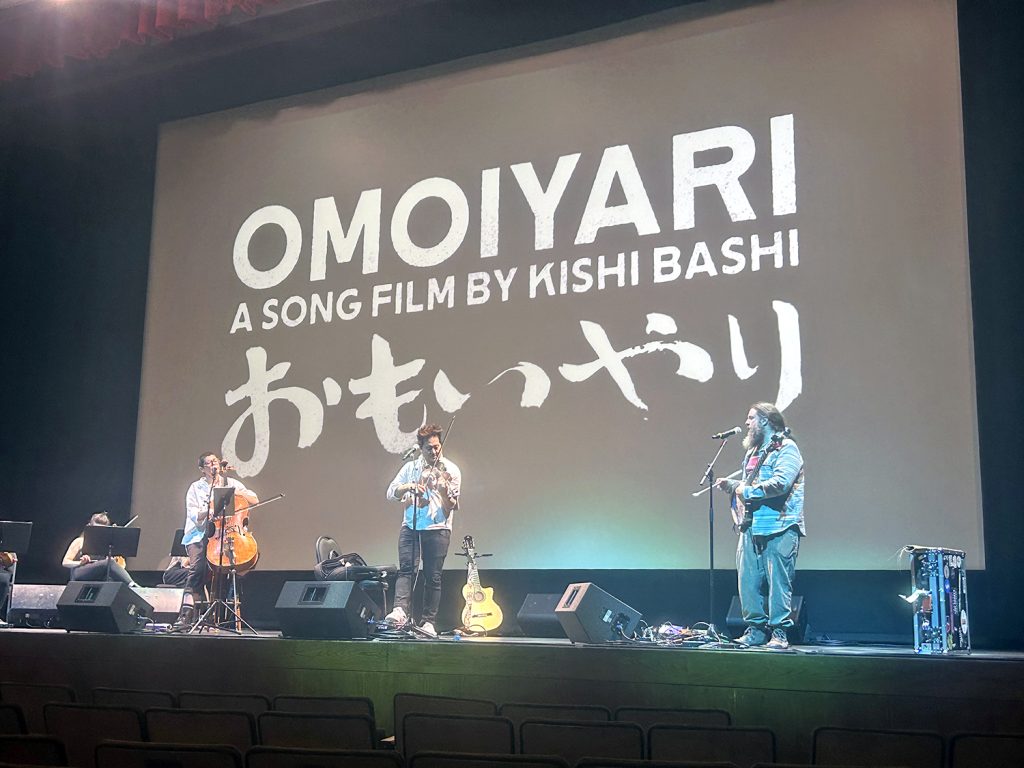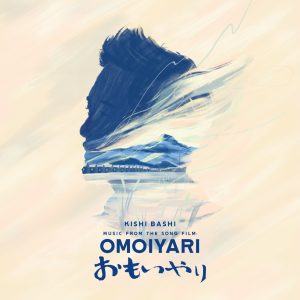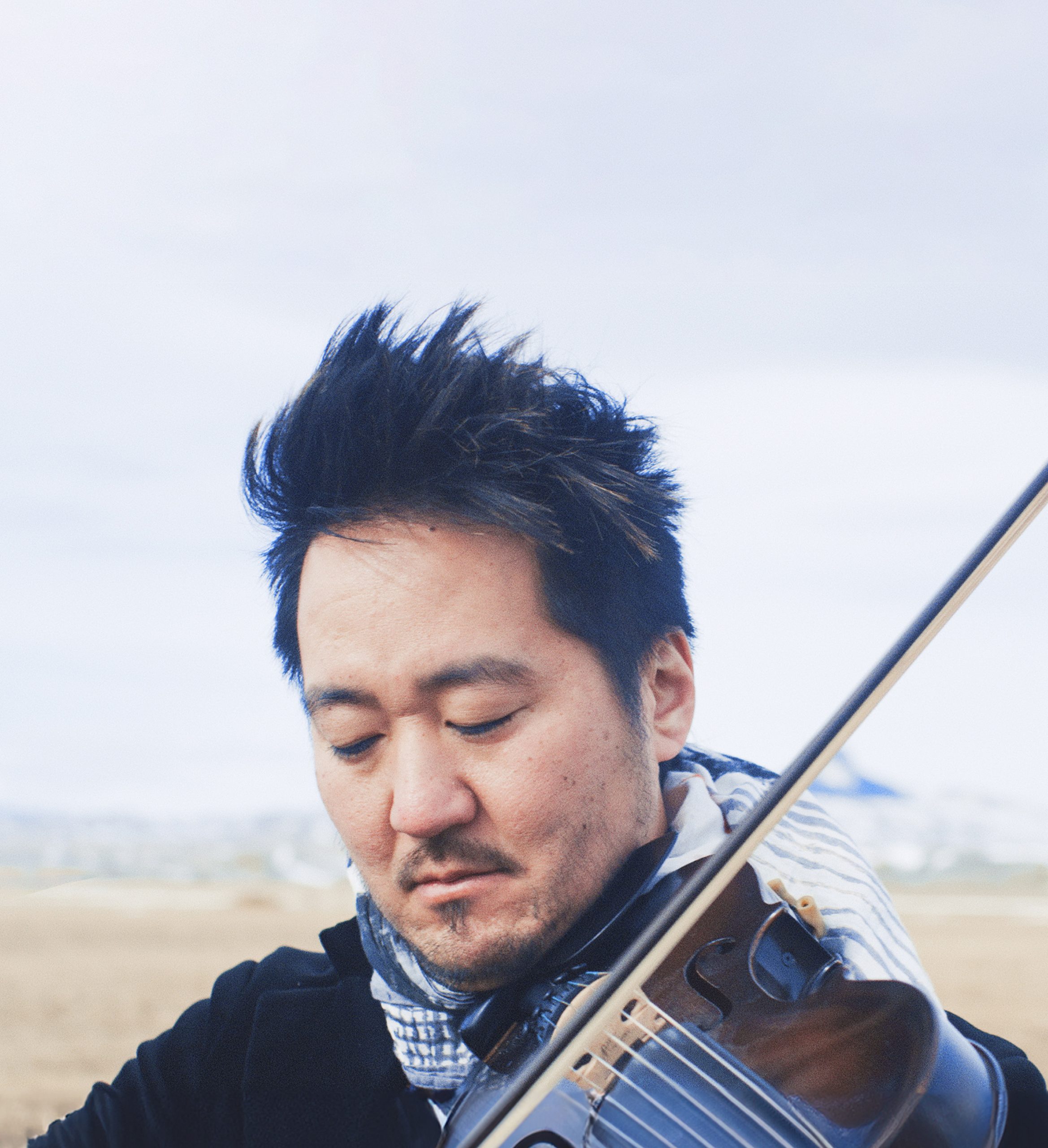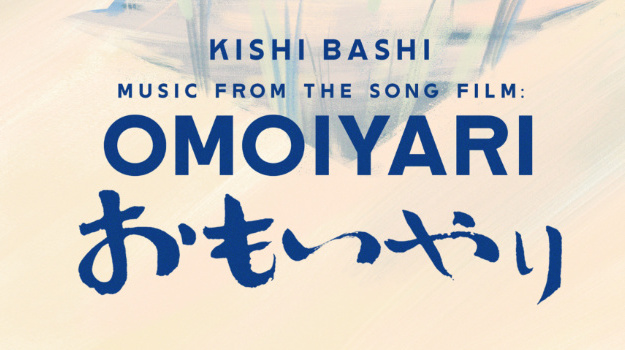With ‘Omoiyari,’ Kishi Bashi gives a soundtrack to the incarceration experience and raises the question: Is there such a thing as Asian Amercan music?
By Lynda Lin Grigsby, Contributor
If the show is where disbelief suspends, and the audience enters a magical world of bounty, the soundcheck is its bare soul. Onstage at the Aratani Theatre, the musicians warm up hours before the seats were filled. String bows dance in the air. The cello mourns loudly. Amid the cacophony, someone is missing.
“Where is K?” someone asks.
On cue, a door at stage right opens, backlit so only a silhouette of a man appears: average height and build with a shock of hair styled in gravity-defying spikes. Before he inhabits his stage persona of Kishi Bashi, the indie rock singer and songwriter, he’s just Kaoru or K.
“Do you want to get on with it?” K asks no one in particular.
(See related story here.)

Kishi Bashi rehearses his music during a soundcheck prior to his performance at the Aratani Theatre in Little Tokyo.
For the soundcheck, he wears a white button-down shirt and carries his phone in a wallet case. For the show, Kishi Bashi dons a pale coat and tie — a signature look that simultaneously nods to and rebels against his classical training.
On this November night, the stakes are high. Kishi Bashi brings his music and film “Omoiyari” to the footsteps of history. In Little Tokyo in 1942, Japanese Americans wore their Sunday best to board buses headed for converted horse stalls and bleak desert barracks — experiences highlighted in the film with black-and-white evacuation photos.

Kishi Bashi’s newest album tells the stories of his experiences learning about the Japanese American incarceration during World War II.
For all the people in these historical photos who may be your family members, Kaoru wants to tell their stories through music in “Omoiyari,” the album and its accompanying “song film,” about his experiences learning about the Japanese American incarceration. The film took six years to make. At the beginning of the journey, he felt insecure in his role.
“Is it my story to tell?” he told me before the soundcheck and performance. “Six years ago, I would not have felt comfortable. Now, I feel pretty confident.”
The lights turn on. Kishi Bashi strides across the stage to an eruption of applause in the sold-out theater, located at the Japanese American Cultural and Community Center in Los Angeles’ Little Tokyo. He slides on the strap of the guitar and strums away disbelief.
Forgotten Words
Kaoru Ishibashi is Shin-Nisei. Shin means new — a new Japanese American.
In a video conversation from his home in Northern California, he gestures toward the window behind him, obscured with boxes and sundries. The Santa Cruz Mountains are behind there, he promises.
Being Shin-Nisei means he has no direct ties with the World War II incarceration experience, except that, as Ishibashi points out in the documentary, if he were born at another time, he would likely be incarcerated, too.
He uses the word “new” often in conversation to describe the Japanese American diaspora.
“New is good because it’s changing,” said Ishibashi. “It also seems fresh. It’s positive.”
During WWII, the Nisei were barely young adults when they were plucked from their homes and placed in untenable situations in desert prisons, courts of public opinion and on distant battlefields to prove their worth. To survive meant suppressing culture and shedding all signifiers of foreignness, including language.
Ishibashi calls this the universal immigrant decision: to transmit or shed culture. In “Theme for Jerome (Forgotten Words),” he mourns this process with both English and Japanese lyrics:
She’d sing this melody
To her beloved sons
Forgotten words from Japan
The song is a nod to a Japanese lullaby but with lost words. In the film, Ishibashi stands alone in the remains of the former Arkansas incarceration site and plays the violin forlornly. It is a devastatingly beautiful scene.

Musician Kishi Bashi in a scene from the film “Omoiyari” (Photo: Courtesy of MTV Documentary Films)
The pseudonym Kishi Bashi, which sounds whimsical and Japanese, is a persona forged out of growing comfort with his bicultural identities. Before that, Ishibashi also jettisoned culture while playing in indie rock bands called Of Montreal and Jupiter One. Back then, he said, there was no space for Asian Americans or Asian Americanness in pop music, so he suppressed his culture into abstraction.
Then, he returned to it.
In the Japanese American community, there wasn’t much space, either. Here, a cultural shorthand ties people together — a byproduct of the war — where people greet each other by mapping their incarceration experience: Santa Anita/Manzanar/Gardena. This leaves little room for a self-proclaimed “postwar immigrant child” from Norfolk, Va.
In high school, Ishibashi’s parents took him to the Smithsonian Museum to complete a project on the incarceration. In 1994, he applied for a JACL scholarship but never heard back.
“It’s OK,” he said. It worked out. He attended the Berklee College of Music.
“The community has been fairly insular,” said Bill Yoshino, former JACL Midwest director, who also appears in the film. “Identity isn’t something that you’re just born into. It can also be learned.”
In the film, Ishibashi pieces together the war narratives through personal interviews with former incarcerees and his own relatives in Japan. The subtext is biculturalism is OK. As Kishi Bashi, he gives permission to celebrate heritage and speak another language.
“Honestly, it’s what makes America great,” he said.
‘Summer of ’42’
Ishibashi is a musician first. His music is orchestral, romantic and lush. He defines his music as indie rock music, specifically experimental indie rock. In press releases of past performances, his music has been classified as Japanese American, which gives him pause.
“I don’t think your ethnicity defines your music,” he said. “If people want to waste one word and add Japanese to American singer/songwriter, then, you know, they can do that. But I don’t think you have to.”
To tell the story of the Japanese American incarceration through music, he reimagines this historical time by putting himself in the place of people in the photos. He focuses on personal stories, not just the conditions and injustice.
In the “Summer of ’42,” Ishibashi sings about young love:
We’d sneak off to the desert
The sand over your fancy shoes
The first day that I met you
I wrote down in my book
I am in love with you
For Ishibashi, there is much more to these war stories than the victimization. Who was loved? Who was left behind? During the turmoil of war and incarceration, people fell in love, had babies, fell out of love and started over — all the things that give life meaning. By focusing on humanity, he brings people back from their modern consciousness to empathize with what it was like in ’42.
He gives this historical event its own soundtrack.
The Japanese word omoiyari means to “have compassion.” Choosing a Japanese word for the album and film’s title was an act of empowerment. MTV Documentary Films released the film theatrically in October and asked for the name to be changed. The reasons are familiar: The title is too hard to pronounce. What does it mean?
“The movie is about embracing biculturalness, so to make us change this title would be like a slap in the face,” said Ishibashi.
The song film “Omoiyari,” as originally titled, makes its streaming debut on Paramount+ on Nov. 21.
A Place for (Asian) American Music
Asian Americans have always been at the center and margins of the mainstream music industry. Since the 1970s, there have been two streams of Asian American artists — those who highlighted Asian Americanness and those who just made music, said Eric Hung, executive director of the Music of Asian America Research Center.
The latter group of modern musicians — Asian Americans who make music — arguably have more name recognition: James Iha of Smashing Pumpkins, Mike Shinoda of Linkin Park and Olivia Rodrigo, the Gen Z pop queen.
Latin music has its distinct sound in the American popular music scene, and so does country and rap — of course, there are crossovers and exceptions — but no such genre is associated with Asian Americans in popular music. It leaves Asian American artists to work in musical spaces that are not their “own.”
In the 1970s, musicians like Nobuko Miyamoto and Chris Ijima’s Yellow Pearl unapologetically made music about the Asian American experience. In their song, “We Are the Children,” they claim their identities:
We are the children of the migrant worker
We are the offspring of the concentration camp
Sons and daughters of the railroad builder
Who leave their stamp on America
The songs and lyrics of consciously Asian American music drive a message and attract (and repulse) a specific audience. In the 1980s, jazz musician and activist Glenn Horiuchi weaved Japanese American themes into his music, but famously said, “and Japanese Americans don’t like it,” according to Hung.
“Omoiyari” is a musical memorial that can help raise awareness among indie rock fans who may not know the Japanese American incarceration history.
“But can it actually lead to meaningful political action?” said Hung. “This is also the inherent problem with music as a political tool. Music by itself does not change laws.”
Hung attended a Kishi Bashi concert in Virginia Beach, where he watched Kishi Bashi perform some of the songs from “Omoiyari” while images of the incarceration looped onscreen. The photos were familiar to Hung, making him wonder if the experience might differ for somebody who didn’t know about the camps.
“Maybe we are not the audience for this,” he said.
In the Aratani Theatre, Kishi Bashi pauses to ask people in the audience to raise their hands if they had family members affected by the WWII incarceration. A few hands shoot up. Most stayed down.
To the raised hands, he dedicates an ode: “Song for You,” about the threat of time and the erosion of memory. He doesn’t clearly define who he is singing to, so the people in the audience, with their hands down, also feel free to imprint their own meaning to the song.
He leaves it open.
Onstage at the Aratani Theatre, Karen Ishizuka, a Sansei curator of the Japanese American National Museum, strides onstage to talk about her family’s incarceration experience.
“Welcome to Little Tokyo,” she says to the audience.
“Omoiyari” is undoubtedly about her story, but this is Kaoru’s story, too, she says. This is the audience’s story. This is your story.
This is an American story.
“Omoiyari” makes its streaming debut Nov. 21 on Paramount+.




